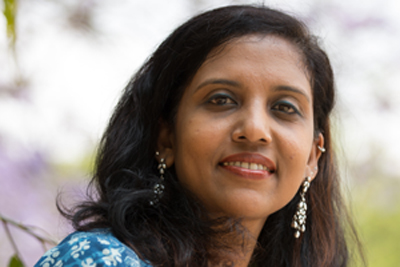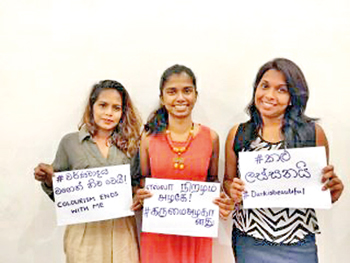Bringing to light the dark side of colourism

Kavitha Emmanuel: Raising awareness in Sri Lanka
Growing up, Kavitha Emmanuel remembers being one of the fairer members of her family. She still used skin-whitening products, but it was meant to preserve her skin tone. “I was not born a campaigner for ending colourism,” she says, “I contributed to the endorsement of the bias in my own way.”
Kavitha, like many Indians, was raised in a society that equated fairness not just with beauty, but with success and even love. The effect was insidious, leaving women struggling to accept themselves. When Kavitha founded Women of Worth, a non-profit programme, where she is today also a director, she began to understand how pervasive the issue was through the experiences of her own colleagues. “We shared our own stories and experiences on the issue and the trauma it had caused among us,” she said.
Kavitha recalls that one of the issues that kept surfacing was that of skin colour bias and how it had damaged people’s sense of self-worth. Accompanying it were these real-life stories of people who faced the issue on a daily basis. “Name-calling, bullying, rejection from potential marriage partners, denied job opportunities and ostracization based solely on one’s skin colour are painful experiences that people with dark skin tones face,” says Kavitha, explaining that the more they talked, the clearer it became that it was something they needed to address.
There were stories like that of Merlin Lilly, a Chennai-based stylist and designer: “Growing up, I was the only dark skinned child among my five siblings. I take after my dad. I remember my close family calling me ‘Karidhana’ – it means ‘blacky’. Growing up, my parents would discourage me from wearing particular colours, especially yellow and blue. They were a big NO. My parents thought that those colours made me almost invisible because of my complexion.”
Merlin also remembers people cracking jokes (“Don’t go out in the dark, you can’t be spotted”) and being shy about being photographed because she would appear darker than her friends.
There were hundreds of stories likes this but something had also begun to shift.
WOW was tracing the obsession with fairness back to colonial times, when white people dominated the country’s centres of power. A layer of class consciousness was added, as dark skin was seen as a marker of someone who laboured outdoors in the sun. However, there was very little reflection around the issue – most people just accepted it as a given. Being fair was preferable, and one simply did whatever one could to be fairer.
Sapna, one of their early campaigners, was featured in a documentary called Hue by filmmaker Vic Sarin. As she became more outspoken, Sapna says she would have people writing to her, asking why she was wasting her time on something so unimportant. In a blog for WOW she tried to frame a response: ‘…After 67 years of independence we still have advertisements that teach our masses that being white is a requirement for being married, getting a job or being a beauty queen. Are you telling me that the masses of Indian brown skinned group of people have no right to be married, get a good job or be called a beauty queen? Is this not discrimination?’
For many, the answer was a resounding ‘Yes.’ It’s now been 10 years since the launch of WOW’s Dark is Beautiful campaign. They’ve seen it take off in a way they couldn’t have imagined. It’s been featured by the media in over 18 countries. In 2013 the campaign went viral on social media with actor-director and social activist Nandita Das as an ambassador and was featured in several television documentaries around the globe. Most notably, in 2014 they applauded as the Advertising Standards Council of India launched their first ever guidelines for fairness products advertisers.

Lankan voices: Campaigning for change
For Kavitha, the last was a particularly critical step forward. “It is a shame that brands are making hay while the sun shines. Instead of standing against the bias, they are endorsing it by promoting ‘unfair’ standards and definitions of beauty,” she says.In fact, hundreds of products are peddled by corporations, among them armpit lightener, genital lightener and fairness baby oil. Nearly all major cosmetic companies (like Dove, Nivea, Pond’s, Garnier, Neutrogena, Olay) sell products that claim to alter genes to suppress melanin. The campaign also highlighted how, Hindustan Unilever, the manufacturer of Fair&Lovely, launched an application to make the skin of Facebook users look lighter in their profile pictures.All these efforts weren’t just targeted at women, as the now infamous Shah Rukh Khan Fair&Handsome ads confirm.
With the corporations focused on profits, the campaign has increasingly turned to ordinary people to bring about the change they want to see. In recent years, Kavitha and her team have been focused on taking the fight against colourism to communities across South Asia. Speaking to crowds, she often points out that many of us are not just victims of colourism, but perpetrators of this unconscious bias as well. She emphasizes that change doesn’t come through pointing fingers, but through each person taking a stand to celebrate skin colour diversity and take positive action in their spheres of influence to end colourism.
It’s this effort that brought her to Sri Lanka where WOW hope to continue the Dark Is Beautiful campaign. She looks forward to finding new collaborators here, and told the Sunday Times: “We welcome stories of people who have survived skin colour discrimination. The more we talk about it, the more awareness will spread. We hope to launch social media pages with relevant information, articles and stories that will help Sri Lanka combat the bias.”
On the campaign’s blog page you can now hear from people like Merlin (who now wears blue and yellow whenever she feels like it) and Sapna who calls on the Indian constitution to protect people from colour discrimination. These are stories of discrimination but also of hope. Perhaps none embodies this change better than that of Pranuthi Bunyan’s family.
The mother of three spoke of how her children were different shades: ‘one chocolate, one coffee and one caramel!’ but that people would always come up to her, point to the fairest and say his colour was “better” than the others. They did this in front of the other two kids. It would take Pranuthi a really determined effort to help her children find confidence in themselves. She knew she had hit the mark when her daughter Sanchitha, aged 12, wrote a poem. It began with the line: ‘Black or white, Red or blue/We are the same/ And that is true.’
Find out more at:
www.darkisbeautiful.in


